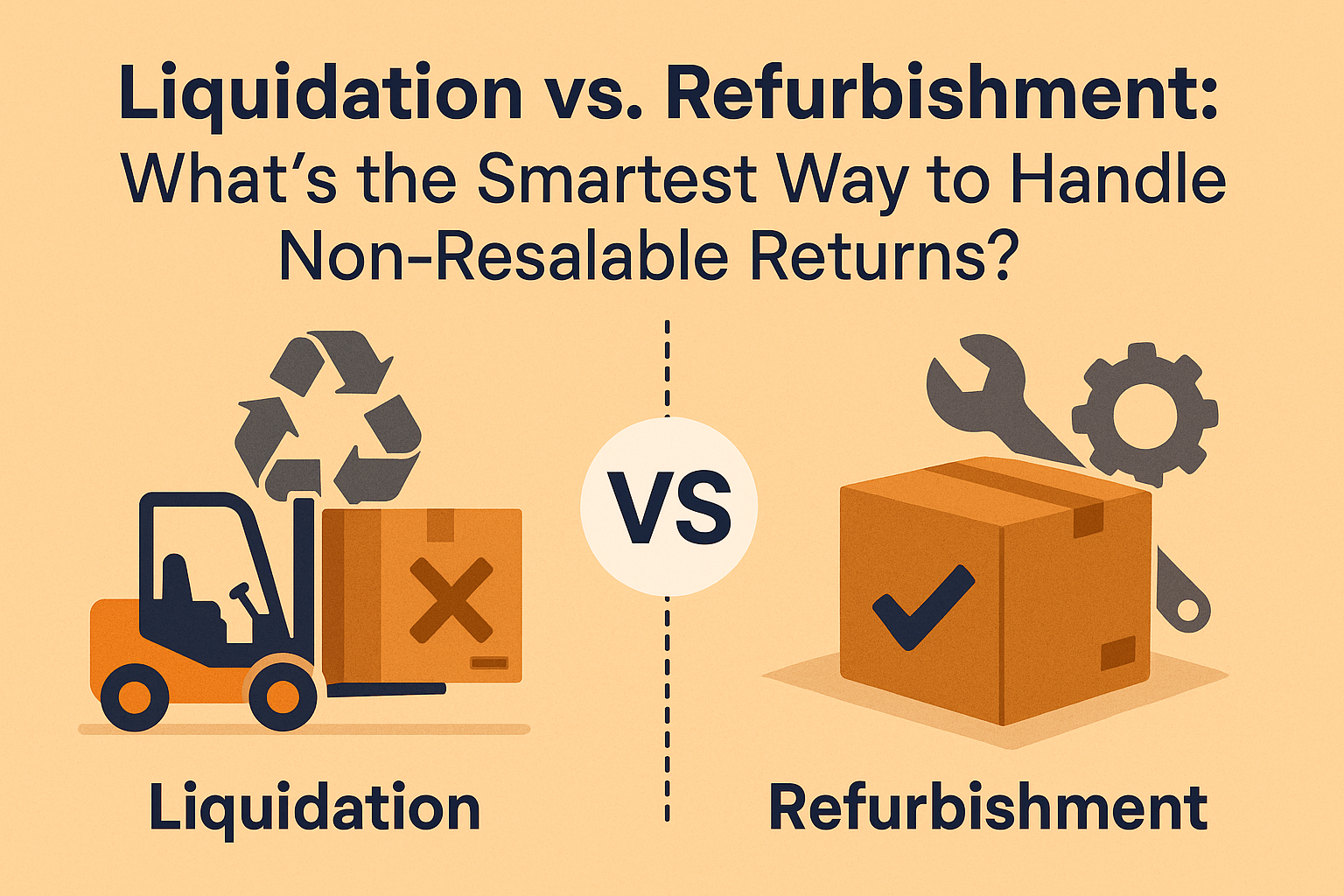In the high-stakes world of e-commerce, a customer return isn’t just an inconvenience; it’s a critical moment that can either eat into your profit margins or be transformed into a new revenue stream. While the initial goal is always to get the returned item back into a resalable condition, a significant portion of products arrive back at your warehouse damaged, used, or otherwise non-resalable. This presents a crucial dilemma: do you liquidate these items at a steep discount, or do you invest in refurbishment to capture more value?
This is more than a simple operational choice; it’s a strategic business decision that directly impacts your brand’s profitability and sustainability. In this in-depth guide, we’ll dive deep into the world of returns, exploring the core differences between liquidation and refurbishment, analyzing their pros and cons, and providing actionable insights to help you choose the smartest path for your business. We’ll also examine real-world scenarios and provide a decision-making framework to guide your strategy.
—
The Modern E-commerce Returns Conundrum
Online shopping has made returns an inevitable part of the business model. What was once a rare occurrence is now a routine part of the customer journey. Unfortunately, not all returns are created equal. A product with a damaged box might be a quick repackaging job, but a defective electronic device or a used piece of clothing requires a more complex solution. According to research, up to 30% of all online purchases are returned, with a significant portion of those being categorized as “non-resalable.”
For many brands, the knee-jerk reaction is to simply write these items off as a loss. However, this approach ignores a huge opportunity to recoup costs and even generate new revenue. The key is to have a robust, well-defined reverse logistics strategy. This is where the decisions of **liquidation vs. refurbishment** come into sharp focus.
—
Liquidation: A Quick Exit Strategy for Non-Resalable Goods
Liquidation is the process of selling off products, often in bulk, at heavily discounted prices to a third party. This can include anything from slightly damaged items to discontinued models or returned goods that are not deemed worthy of repair or restocking.
How Does Liquidation Work?
Typically, a business partners with a liquidator or uses an online liquidation marketplace. Products are often sold in large lots, sometimes sight-unseen, to buyers who specialize in reselling discounted merchandise. This can be a quick and relatively painless way to clear out inventory and recover some capital. For an e-commerce business, a streamlined returns management process is critical to efficiently sorting and routing items for liquidation. For a deeper look at streamlining these operations, check out our Return Management Solutions.
Advantages of Liquidation:
- Speed and Simplicity: It’s a fast way to get unwanted inventory off your books. You don’t have to worry about repairs, cleaning, or individual reselling.
- Cash Flow: While you won’t get full price, it provides an immediate cash injection that can be reinvested into other parts of your business.
- Space Optimization: It frees up valuable warehouse space that would otherwise be occupied by stagnant, unsalable inventory.
- Reduced Labor Costs: It minimizes the need for internal staff to inspect, repair, or re-list individual items.
Disadvantages of Liquidation:
- Low Recovery Value: You are often selling at a fraction of the original retail price, sometimes as low as 10-20% of the MSRP.
- Brand Perception Risk: If your liquidated products end up on discount sites or in brick-and-mortar bargain bins, it can devalue your brand’s image.
- Lack of Control: Once the products are sold, you have no control over how they are marketed or who the end buyer is.
—
Refurbishment: Unlocking Hidden Value from Returns
Refurbishment is the process of inspecting, repairing, cleaning, and repackaging a returned product to bring it back to a like-new or “certified pre-owned” condition. This allows you to resell the item, often at a slight discount, but at a significantly higher price than liquidation.
How Does Refurbishment Work?
Refurbishment requires a more hands-on approach. Returned items are first inspected to determine the level of damage or wear. They are then sent to a specialized team or a 3PL partner with refurbishment capabilities. This process can include everything from simple cleaning and repackaging to replacing parts, updating software, and extensive quality assurance testing. For more about comprehensive logistics support, including refurbishment capabilities, explore our Services page.
Advantages of Refurbishment:
- Higher Revenue Recovery: You can recapture a much larger portion of the original sale price, often 50-80% or more.
- Brand Integrity: Refurbished items can be sold directly on your own website, allowing you to control the marketing, pricing, and overall customer experience.
- Sustainability: It’s an environmentally friendly practice that reduces waste and extends the life of a product.
- New Customer Segment: It allows you to tap into a new market segment of budget-conscious consumers who are actively seeking quality refurbished goods.
Disadvantages of Refurbishment:
- Higher Operational Costs: The process is more labor-intensive and requires a skilled workforce, specialized tools, and a robust quality control system.
- Time and Complexity: It takes time to process, repair, and re-list a product, which can lead to inventory bottlenecks.
- Quality Assurance Risk: If not done correctly, a poorly refurbished product can lead to customer dissatisfaction and negative reviews, damaging your brand’s reputation.
—
Comparative Analysis: Liquidation vs. Refurbishment
To help you better understand which strategy is right for your business, let’s break down the key differences in a side-by-side comparison. For businesses dealing with high volumes of returns, partnering with a 3PL like WarehouseTX can provide the expertise and infrastructure to manage both of these processes efficiently.
| Feature | Liquidation | Refurbishment |
|---|---|---|
| Revenue Recovery | 10-30% of MSRP | 50-80%+ of MSRP |
| Operational Complexity | Low (bulk sales) | High (inspection, repair, testing) |
| Labor & Cost | Low | High |
| Time to Cash | Fast | Slower |
| Brand Impact | Potential for brand devaluation | Maintains or enhances brand image |
| Environmental Impact | Often leads to more waste | Promotes circular economy, reduces waste |
—
Case Studies: Choosing the Right Path
Case Study A: A Fast-Fashion Brand
The Challenge: A popular online fast-fashion retailer receives a high volume of returns due to size issues, color discrepancies, or simple change of mind. Most of these items are in perfect condition but are non-resalable because of a quick sales cycle or minor packaging issues.
The Strategy: This brand chooses a hybrid model. A significant portion of returns are deemed resalable after a simple quality check and repackaging. However, a smaller percentage that show minor signs of wear or are from a previous season are immediately sent for liquidation. The brand has a deal with a liquidator to sell them in bulk lots to discount retailers. This approach ensures they quickly recoup some value and maintain a lean inventory, aligning with their fast-cycle business model. They prioritize speed and efficiency over a small increase in revenue per item.
Case Study B: A High-End Electronics Company
The Challenge: A company selling high-end headphones and speakers faces returns where a small component might be defective, or the product has minor cosmetic scratches. The original retail price is high, so losing the full value of the product is a significant financial hit.
The Strategy: This company invests heavily in refurbishment. They have a dedicated team of technicians who inspect, repair, and test every returned product. They replace any faulty parts, meticulously clean the devices, and repackage them in a new, distinct box. These “certified refurbished” products are then sold on a special section of their website at a 20-30% discount. This strategy not only recovers a massive portion of the cost but also creates a new, attractive product line for customers who are brand-loyal but looking for a better deal. It also reinforces their commitment to quality and sustainability.
—
Building Your Decision-Making Framework
So, how do you decide between liquidation and refurbishment? The answer lies in a structured, data-driven approach. Ask yourself these key questions:
- What is the original retail value of the product? High-ticket items (electronics, luxury goods) often make refurbishment a more profitable choice. Low-cost items (apparel, accessories) might be better suited for liquidation due to the high cost of labor relative to their value.
- What is the nature of the return? Is it a simple packaging issue or is there a functional defect? Simple issues are perfect for refurbishment. Complex or severe damage might make liquidation the only viable option.
- What are your brand values? If sustainability and a circular economy are core to your brand’s identity, refurbishment aligns perfectly.
- What is your team’s capability? Do you have the internal expertise, or a 3PL partner with the right services, to handle the complexities of refurbishment?
- What is your inventory volume? If you have a massive volume of returns, a hybrid model may be necessary, with the bulk of non-resalable items being liquidated while a select few are refurbished.
The most successful e-commerce businesses often employ a hybrid model, using both strategies strategically. By partnering with a 3PL that offers comprehensive Return Management services, you can have a team of experts analyze your specific situation and manage the logistics of both liquidation and refurbishment, ensuring you make the most out of every returned item.
—
Frequently Asked Questions
What is the difference between liquidation and refurbishment?
Liquidation is the process of selling non-resalable products in bulk to a third party at a steep discount, often recovering only a small fraction of the original price. It is a quick and simple way to clear inventory. Refurbishment is the process of repairing, cleaning, and repackaging a returned item to a like-new condition, allowing it to be resold for a much higher price, typically on the brand’s own channels.
Is refurbishment always more profitable than liquidation?
Not always. While refurbishment offers a higher potential revenue recovery per item, it also comes with higher labor, time, and operational costs. For low-cost items or products with severe damage, the cost of refurbishment may outweigh the potential profit, making liquidation the more sensible choice. The profitability depends on the item’s original value, the cost of repair, and the volume of returns.
How can a 3PL help with liquidation and refurbishment?
A 3PL (Third-Party Logistics) provider with expertise in reverse logistics can streamline the entire process. They can receive, inspect, and sort returned items. Based on pre-agreed criteria, they can then either prepare the items for liquidation by consolidating them into lots or manage the refurbishment process with skilled labor. This partnership allows e-commerce brands to focus on their core business while maximizing the value of their returned inventory.
Does refurbishment help with brand reputation?
Yes. By offering “certified refurbished” products on your own site, you maintain control over the customer experience and quality. This not only builds trust but also shows your brand’s commitment to sustainability and product longevity. In contrast, liquidation can sometimes devalue a brand if the products end up in unmanaged discount channels.

